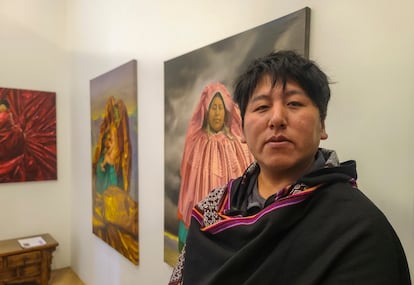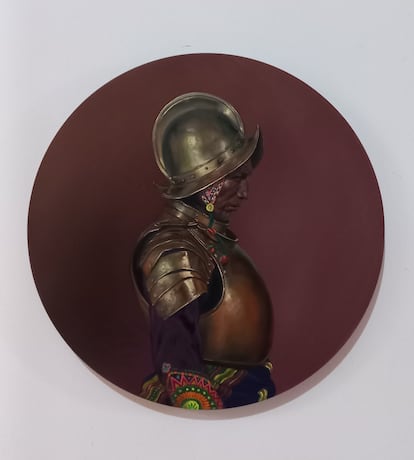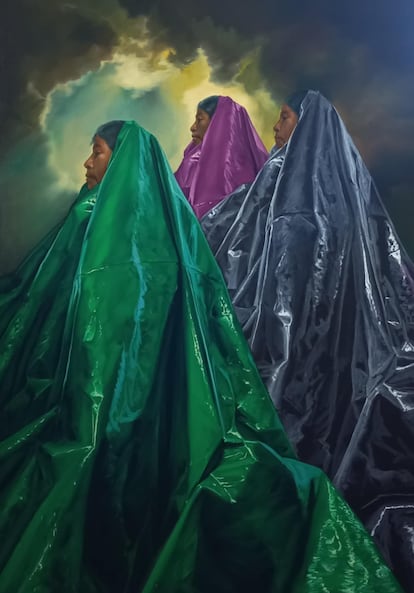The painter Cristian Laime (36 years) inevitably associates his childhood with Lake Titicaca, the largest in South America. The town where it was born, Carabuco (La Paz, Bolivia), on the shores of this millenary body of water, granted privileged views. As well as an unconscious mysticism that exhales the lake, almost 4,000 meters above sea level, ceremonial center for 2,000 years: first for Tiwanacotas and, then and until today for the Aimaras. Therefore, when he copied at the Academy of Fine Arts of La Paz portraits of the Dutch Golden Age or Renaissance sacral scenes, it naturally included coca leaves, mantles or colorful skirts. The reinterpretation that makes the history of art with indigenous hands – making his work in something as Bolivian as universal – has led him to be one of the most media Andean artists of the moment.
“I seek to portray our time from our place. In that process, the unavoidable need to contemplate our past arises,” explains the artist to El País at the Patiño Foundation in Cochabamba. The sample has just opened Memoryavailable until June 27. It is his first major event of the year, after having opened six exhibitions in four cities during 2024, a season that closed with the distinction of Knight from the Order of the Arts and Lyrics granted by the Embassy of France. This 2025 is still waiting for the premiere of your documentary Cristian Laime 3868 and an individual exhibition in Hamburg, with works on the facades of the choletsSingular architecture buildings of El Alto, Paz Ciudad where he currently lives. “I just have been doing full time for five years. I think my career is just beginning,” he says.
The fusion of Aymara identity elements with surreal atmospheres, on some occasions, or baroque, in others, has aroused the interest of collectors both in Peru and Mexico, in France and the United States. In their canvases, the apostles of The Last Supper They give way to cholas – Quechua and Aymara indigenous women who retain their traditional clothing – celebrating a paythe community festivities of El Alto; The characteristic cherubs of the Baroque flutter between Aguayos; and the Virgin Mary of the Immaculate Heart is actually a peasant wrapped in coca leaves. On this last reason, embodied in the picture Coca mother (2024), Laime explains: “It is a syncretism that is made from the colony. The Incas associated the Virgin Mary with Mother Earth, La Pachamama.”
The look towards the past of the Paceño painter is both global and specific, when reviewing the story of Bolivia with sarcasm and mordacity. Memory He welcomes the viewer with a series of paintings that refer to the official portraits of presidents of the nineteenth century, when caudillist governments whose mandates sometimes did not reach six months proliferated. But Laime represents them with Aymara or Quechua female elements, such as braids and hypes. “I claim the fact that until some time in the country’s history the indigenous side refused: all the presidents were of the elites.”
Devotion to the mother
In another of these paintings, a Paceña chola, dressed with shoulder pads of an old military uniform and a police hat, it would be serious to the viewer. “They are trades traditionally assigned to men. I like to break those gender molds: female attire in very male men, or vice versa.” Laime paints the urban indigenous woman as a hero of the Republic, guerrilla or head of state. The model that appears in 80% of its paintings since 2020, according to the artist himself, is his mother. In fact, he has not had another female model in flesh and blood other than her.

The Paceño painter is the only son of a single mother, who was “Minera, merchant, mother and father,” he says. “We developed such a rooted connection that I got to develop a phobia to loneliness, that is, to its absence. During the pandemic, the only two human beings in my house were she and I, so I began to portray it. I was afraid of not being able to technically achieve its image, I did not have so much confidence. Now I feel that I have managed to portray it and that gives me up something in a certain way. He affirms that his mother, Amalia Yujra, is happy with the result, that his face has traveled the world.
Laime says that she always felt supported by her, despite the fact that the art market in Bolivia depends largely on the purchase by foreigners. His first works were made in Primary, copying the drawings of his school books. “I charged my friends for doing the duties of plastic arts. Everyone learned, and I ended up doing them for other courses too. In the year’s end exposure of the school, 90% were my paintings,” he says. His vocation was clear, and studied at the Hernando Siles de la Paz Academy, in addition to obtaining a degree in Plastic Arts at the Public University of El Alto (UPEA).

Art with meaning
During his training, one of his teachers was the contemporary artist Gastón Ugalde. Developed in 2023 at 79, he was one of the most important plastic creators of the second half of the twentieth century in Bolivia. His work had a strong political character, with criticism of the military regime of the seventies and early eighties. He was interested in his student’s work and recruited him as an assistant to his workshop in part time. “It made me notice that art is not only a technical search, but also conceptual (…) for me an art with meaning is important.” A sample of that social line is oil National Anthem, General Choir (2018), which obtained the Grand Prix of the Pedro Domingo Murillo Hall – the oldest and most prestigious contest in the country – which awarded him about $ 6,000.
That artistic and economic recognition ended up promoting his career: “Until that moment I had vocational doubts, I asked me if I could live from art.” The canvas of more than two meters recreates a demonstration during the known as Gas de 2003, which rejected the export of the resource to Chilean and American companies. The clashes between protesters – mostly neighbors of El Alto – and military left about 67 dead civilians.
Another of his works in this line is an allegorical portrait of Evo Morales, exhibited in 2019 at the Tambo Quirquincho. In the current sample this criticism continues to power with Scrutiny (2025). This large format oil shows a group of rats taking off the presidential medal. They are scattered around the chair that will play 10 candidates in the presidential elections of August 17. It was one of the most photographed pieces during the inauguration, because it symbolizes what is coming: crucial elections, in which much of the population deposits their hopes to overcome the deep economic crisis in which the country is located. “There is a general pessimism about the future, about the possibility that the leaders we should choose are not the most suitable. It is an acquired right of artists to portray collective feeling.”

